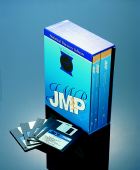 The statistical world is broad and varied. This also is true of software products developed to provide statistical data analysis. Statistical software range from basic control charts and capability indexes -- used by many manufacturing facilities -- to more sophisticated software, such as JMP. The statistical world is broad and varied. This also is true of software products developed to provide statistical data analysis. Statistical software range from basic control charts and capability indexes -- used by many manufacturing facilities -- to more sophisticated software, such as JMP.
This is not your everyday statistical software. Yes, it can be used for simple line charts and distributions, but the beauty of this product is its ability to handle more complex analysis in a straightforward manner. Although the average quality assurance department, charged with determining product/process output conformance, may not need to generate a Kaplan-Meier life table, the software has that capability. JMP includes six statistical analysis platforms: 3-D spin plot, univariate statistics, analysis of variance and multiple regression, nonlinear fitting, multivariate analysis and nonparametric tests. For those involved in quality improvement, the software offers graphical tools designed for quality control, including Shewhart control charts and Pareto charts. It also has complete design of experiments and offers five classical designs for estimating the effect of one or more factors on a dependent variable. Quality control and process personnel will like JMPís real-time statistical process control capabilities. The program allows users to connect a measurement device to a computerís serial port and collect data in real time. Each time a batch of data (five to 20 measurements) is taken, a new point is added to a Shewhart chart, and limits are recalculated. If the process goes out of control based on any combination of eight criteria, an alarm sounds. JMP process control charts include mean, range, standard deviation, individual measurement, moving range, UWMA, EWMA, cusum, p, np, c and u. Unequal batch sizes are supported. The JMP software loaded easily. Using the tutorials proved relatively easy, with standard Windows-type interfaces. The manuals were helpful and informative, especially the introductory guide. It followed the unwritten rule regarding manual usability for those who assemble things without directions: If a software manual is more than 1/2Ē thick, itís too much information to bother. The introductory guide is just the right size for those of us with enough knowledge to be dangerous and enough curiosity to learn something. JMPís data entry spreadsheets should be familiar to anyone who has used Excel or similar spreadsheet applications. All data tables can be sorted or manipulated just like spreadsheets. This makes data entry both unassuming and intuitive. In reviewing the product and running through the tutorials, it was immediately apparent that this software isnít for the average shop-floor operator. Choosing the analysis method requires a higher understanding of statistics than most of us can muster, but the process is easy enough, provided users know what they are looking for. Iíve used similar products in pharmaceutical experimental responses and applied the same data in JMP. The results were excellent, with graphical representations as good as or better than competing products. Changing analysis methods was as easy as pointing and clicking the mouse a couple of times. Itís worth noting that JMPís user interface is highly refined. The screen always displays either the data or an analysis with graphics. The software avoids control screens or palettes that block the userís view of data by keeping controls out of the main field of view or integrating pop-up menus within the current view. The mouse handles almost all control. Clicking on virtually anything -- plots, columns, axes, icons -- allows you to change those items or calls up a submenu. Click on any point in a graph or select data in a spreadsheet, and every place that data is used is highlighted. As I used the program, I began to visualize its potential for adventurous statisticians, as well as manufacturing and quality engineers. The program is especially useful when determining which process variables have the most impact in order to optimize that process. JMP may provide more functionality than the average quality manager currently needs. However, thereís a lot to be said for having tools that allow you to grow. This product does many things well and would be a great software addition to research laboratories, advanced manufacturing operations, statistical experimenters and quality managers who want a full array of tools at their fingertips. JMP by SAS Institute Inc. System requirements: For Windows -- 386 or higher processor, 8 MB RAM recommended, 8 MB disk space. Windows 3.1, NT 3.51 or 95. For Macintoshes -- any 680x0 or Power Mac with System 7.0 or greater. 8 MB RAM and 8 MB disk space recommended. Price: $695. Quantity and academic discounts available. Contact: SAS Institute Inc.
SAS Campus Drive
Cary, NC 27513-2414
Telephone: (919) 677-8000
Fax: (919) 677-4444
www.sas.com About the author Lee D. Dawson is president of Quality Associates International Inc. in Dearborn, Michigan. Call QAI at (313) 565-6266 or visit the companyís Web site at www.quality-one.com. |

